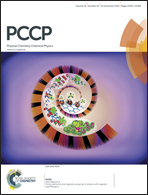Doping indium in β-Bi2O3 to tune the electronic structure and improve the photocatalytic activities: first-principles calculations and experimental investigation†
Abstract
β-Bi2O3 is an efficient visible-light photocatalyst, however, it is unable to split water to produce hydrogen because of the positive conduction band minimum (CBM). In this paper, using hybrid density functional theory (DFT) calculations, we demonstrated that by doping indium in β-Bi2O3, the CBM shifts upward because of the orbital hybridization of Bi, In and O. In-doped β-Bi2O3 photocatalysts synthesized using a precipitation method can photocatalytically split water to produce hydrogen in experiments. In-doping also causes the morphological change of β-Bi2O3 from the hierarchical bulk assembled by nano-sheets to a spongy-like brick. Furthermore, In-doping induces the formation of electric dipoles along the tunnel in the crystal and decreases the effective mass of the electrons, favouring the separation of electron–hole pairs and electron mobility. Therefore, In-doped β-Bi2O3 has much better performance than that of the pristine β-Bi2O3 for photocatalytically decomposing methyl orange (MO) solution. This idea of simply incorporating an isovalent single element into photocatalysts to elevate the CBM and tune the local crystal structure is anticipated to be very useful for designing efficient photocatalysts.


 Please wait while we load your content...
Please wait while we load your content...